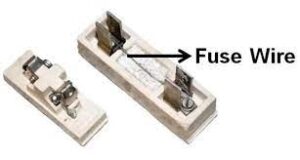Fuse wire is typically made up of a low-melting-point metal or alloy. The purpose of fuse wire is to provide a sacrificial element in an electrical circuit that melts or breaks when an excessive current flows through it. This helps protect the circuit from damage due to overcurrent or short circuits. In general, the fuse wire is made up of an alloy of Tin (Sn) and Lead (Pb).

However, the specific material used for fuse wire can vary depending on the application and the desired characteristics of the fuse. Some common materials used for fuse wire include:
- Copper: Copper fuse wire has a low melting point and good electrical conductivity. It is commonly used in low-voltage applications.
- Silver: Silver fuse wire has excellent electrical conductivity and a lower melting point than copper. It is often used in high-performance or high-current applications.
- Tin: Tin fuse wire has a relatively low melting point and is commonly used in household fuses.
- Lead: Lead fuse wire has a low melting point and is used in some older fuse applications. However, due to environmental concerns related to lead toxicity, its use has decreased in recent years.
The choice of fuse wire material depends on factors such as the rated current of the circuit, the expected fault currents, and the desired response characteristics of the fuse. It is important to select the appropriate fuse wire material to ensure the proper protection of the electrical circuit.
When does the fuse wire melt?
When a current exceeding the rated capacity of the fuse flows through the circuit, the heat generated by the excessive current causes the fuse wire to reach its melting point. Once the fuse wire melts, it breaks the circuit, interrupting the flow of current. This action helps prevent further damage to the electrical system, such as overheating, fires, or damage to connected equipment.
When a fuse wire melts, it is essential to replace it with a new fuse wire of the correct rating. This ensures the proper functioning of the circuit’s protection and restores power to the system after addressing the cause of the excessive current flow.
Fuse wires are considered one-time-use components, and their melting indicates the need for further investigation into the cause of the overload or excessive current. Possible causes can include short circuits, faulty electrical equipment, or improper wiring. Identifying and addressing the underlying issue is crucial to prevent a recurrence and maintain electrical safety.
Important Links